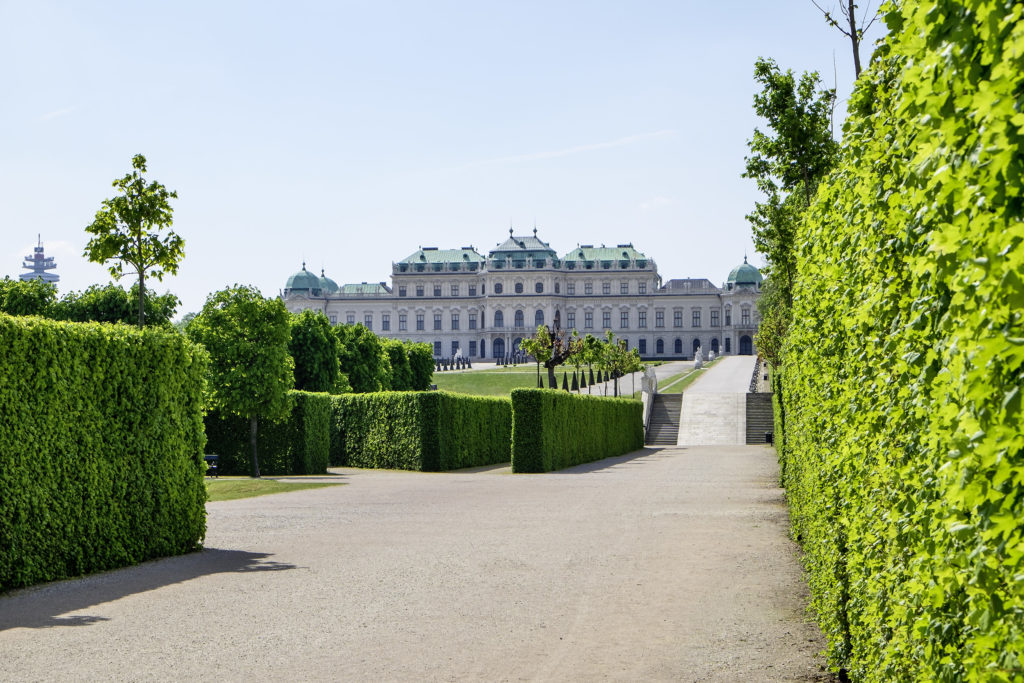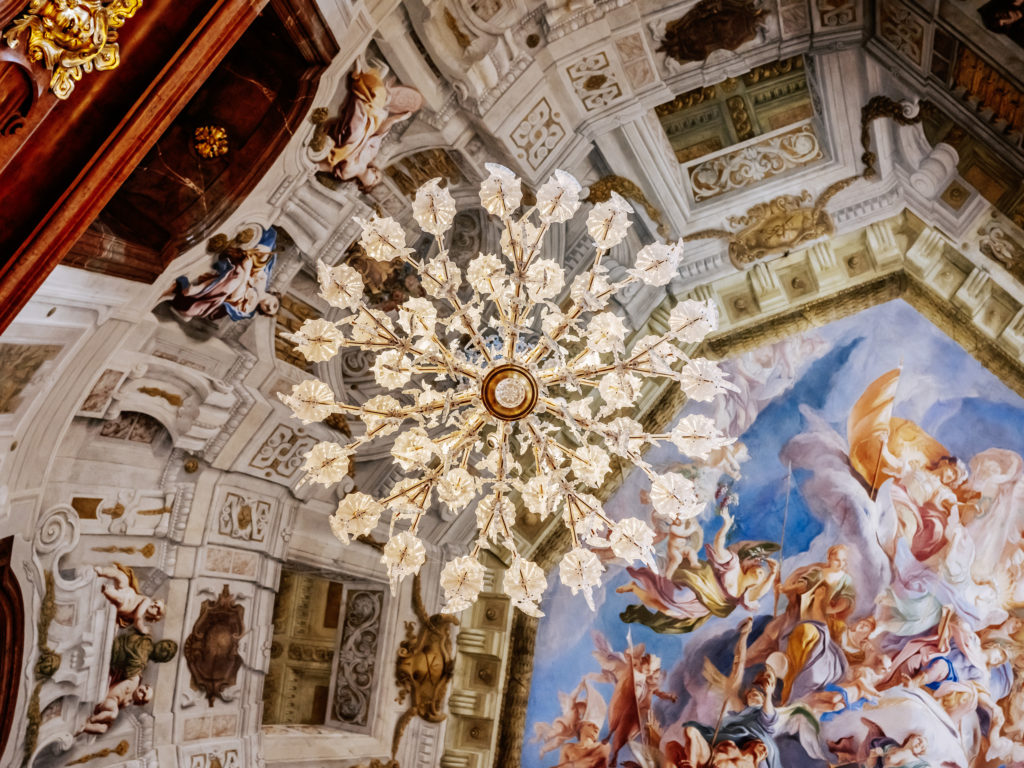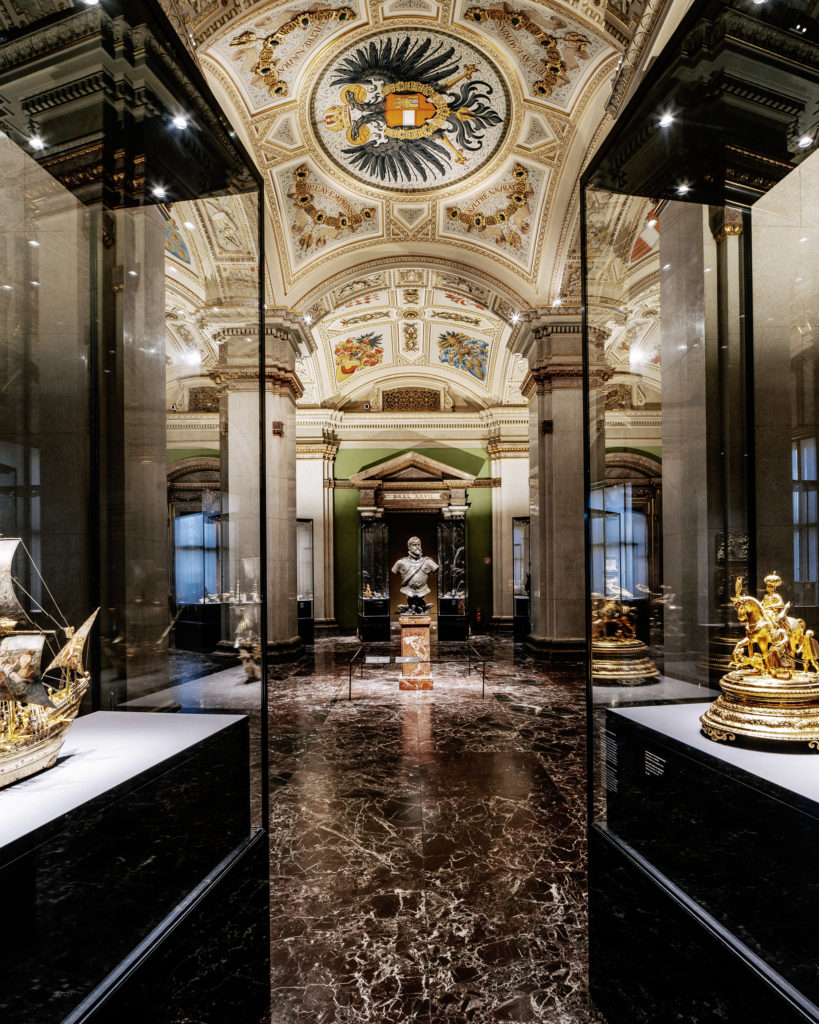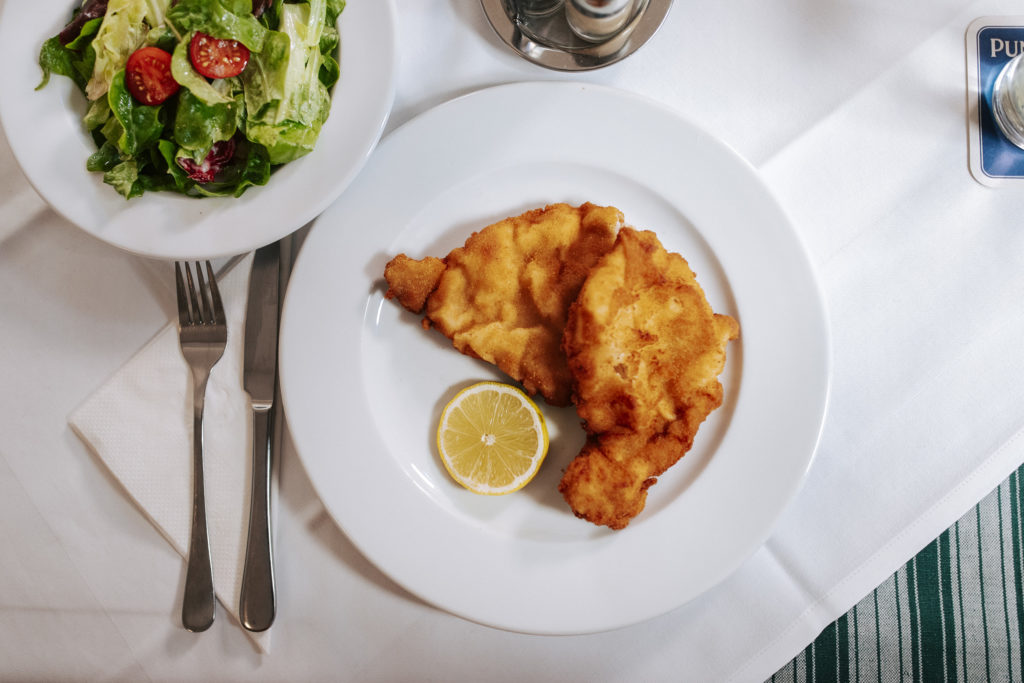The City of Vienna
Vienna – Something Old & Something New
With its successful blend of imperial tradition and contemporary creativity, the Austrian capital has established itself as a major player in the global tourism market. With 16.5 million overnight stays in 2018, beating the previous record set in 2017 by 6.3 percent, the Viennese tourist industry posted the best performance in its history. In 2018 the International Congress and Convention Association (ICCA) ranked Vienna in second place.

Legend: Above the roofs of Vienna
Vienna is not only the capital of Austria, but also one of its nine federal states. St. Stephen’s Cathedral, considered the center of the city by its inhabitants, is located 16º 22’ 27’’ east of Greenwich at 48º 12’ 32’’ northern latitude, and 171 meters above sea level. The city covers 415 square kilometers and is divided into 23 districts. With woods, grassland, parks and gardens accounting for around half its area, Vienna is the city in Europe with the highest ratio of green space. “Urban green” such as Stadtpark (with one of the most frequently photographed sights in the city, the golden Johann Strauss monument) is joined by the woods and grassland of Prater, the extensive Schönbrunn Palace Gardens, sections of the Vienna Woods, vineyards, farmland and the wetlands of the legendary Danube River. During the summer temperatures rarely rise above 30º C, and in winter they hardly ever fall below -5º C. Schönbrunn Palace and its park were added to the UNESCO World Cultural Heritage list in 1996, followed by the historic city center in 2001.
From Roman Camp to Capital of the Republic

Vienna’s history goes even farther back but it made its first major breakthrough at around 15 B.C., when the Romans founded the military camp Vindobona. The city of Vienna is mentioned in documents dating back to 1137. Around 1155 the Dukes of Babenberg chose it as their residence, and from 1278 it was where the Habsburgs reigned more than six centuries. Today’s cityscape is dominated by the Baroque and the reign of Empress Maria Theresa. However, Emperor Franz Joseph I also made his mark on the city when he leveled the city walls in 1857 and oversaw the completion of the splendid Ring Boulevard. He died during World War I after reigning for 68 years. In 1918 Vienna became the capital of the Republic of Austria. Following the annexation of Austria by Nazi Germany in 1938, Vienna was designated a “Reichsgau” (an administrative district of the Third Reich). In 1945, it was again proclaimed capital of the Republic of Austria. The city became one of four United Nations headquarters alongside New York, Geneva and Nairobi, in 1979 the UN complex at opened on the banks of the New Danube, and in 1995 Vienna joined the ranks of European Union capitals.
Imperial Romance and World-Class Art
Vienna owes its universal appeal to the way it excitingly combines imperial nostalgia with a highly creative cultural scene, responsibly cultivating a precious heritage and charming traditions whilst taking on board the latest trends. Architecture dating from imperial times has left an indelible mark on the city. Magnificent edifices, predominantly in baroque, historicism (“Ringstrasse”) and art nouveau styles, and the city’s grand scale cause you to forget that this is the capital of the small Republic of Austria with around 8.8 million inhabitants.

Yet it is not only the city’s imperial architecture that renders it a city of beauty. Vienna also boasts world-renowned museums, art collections and works of art. The Kunsthistorisches Museum Wien (Museum of Fine Arts) houses the world’s largest collection of paintings by Bruegel, as well as the Kunstkammer, a unique collection of artifacts and oddities. Meanwhile numerous works by Gustav Klimt and Egon Schiele are exhibited at the Belvedere and the Leopold Museum in the MuseumsQuartier. This centrally located, world-class cultural complex is an architecturally fascinating combination of baroque (the former Imperial Stables) and future-oriented design by architects Ortner&Ortner. With 60,000 square meters of usable floor space on eight different levels, it is one of the largest cultural complexes in the world, offering a unique mix of uses.
Key attractions include: the Leopold Museum (mentioned above) with the world’s largest collection of Schieles and works by renowned modern Austrian artists such as Klimt, Kokoschka and Gerstl; the mumok – museum moderner kunst stiftung ludwig wien, Architekturzentrum Wien, and Kunsthalle Wien. Two festival halls are used for high-profile events such as the Vienna Festival, the ImPulsTanz dance festival and even for pop concerts. A children’s museum, a children’s theater, an information center for youngsters, and a number of attractive restaurants, cafés and shops complement the rich array of cultural offerings.

Close to the State Opera House, the Albertina houses one of the world’s largest and most important collections of graphic art, spanning 50,000 drawings and watercolors, and around 900,000 prints. The Belvedere palaces and formal gardens make up one of Europe’s most attractive Baroque ensembles. The Upper Belvedere is home to one of the nation’s most valuable art collections, which features key works by Gustav Klimt, Egon Schiele and Oscar Kokoschka. Among the absolute highlights is the world’s largest collection of oil paintings by Gustav Klimt including his best-known composition, The Kiss. By contrast, the Lower Belvedere and the Orangery host a constantly changing line-up of seasonal exhibitions. A short distance from the Upper Belvedere is Belvedere 21, the former Austrian pavilion from the 1958 World Exhibition, which was given a new lease on life as Vienna’s modern art museum from 1962 to 2001 under the name “20er Haus”. Today, this adapted architectural gem presents Austrian art from 1945 to the present day in its international context.
On April 24, 2004 – 150 years after the marriage of Empress Elisabeth (1837–1898) and Emperor Franz Joseph I (1830-1916) – the Sisi Museum opened at Hofburg palace. The exhibits on show include a number of Elisabeth’s personal belongings including a replica of the dress she wore on the eve of her wedding, her morning coat, and the monarch’s parasol, fans and gloves. A walk-in reconstruction of the luxury state railway carriage used by the travel-mad empress can also be viewed.
City of Music – Traditional & Modern
Vienna has traditionally accorded the arts great respect, and over the centuries has never ceased to foster creativity and attract people from all over the world. Vienna boasts 50 theaters, including four opera houses and several stage musical theaters, more than 100 museums, numerous galleries, and renowned drama, music and dance festivals. All this ensures an extraordinarily rich cultural program throughout the year, making the city one of Europe’s leading cultural centers.

Vienna, as a city of music, enjoys a paramount reputation around the world. No other city has been home to so many composers of international renown. Some, such as Schubert, Strauss, Schoenberg and Berg were born there, others, such as Mozart, Beethoven, Haydn, Brahms and Mahler chose to live there. It boasts one of the world’s finest orchestras – the Vienna Philharmonic – as well as the Vienna Symphony Orchestra and several other orchestras and ensembles of note. The Vienna State Opera is one of the world’s leading opera houses, and is joined by three more in the city (Theater an der Wien, Volksoper, Kammeroper).
The Vienna Boys’ Choir enchants music lovers the world over. The choir’s new state-of-the-art concert hall, MuTh, is located next to the boys’ school and residences in the Augarten park, opened in 2012. In addition to classical music, Vienna has also made its mark as a city of musicals, and recent successes in electronic music show that the avant-garde is also taken seriously in Vienna. A very special way to enjoy music is presented at the House of Music – a unique high-tech voyage of discovery into the phenomenon of music – where sounds become visible, organ pipes may be walked on and visitors can become virtual conductors and composers, all on an area of 2,000 square meters. A further attraction is the Mozarthaus Vienna, located in his former residence at Domgasse.
Lifestyle: Imperial Nostalgia & Contemporary Trends
The juxtaposition of what is traditional – coffeehouses and wine taverns with typical Viennese congeniality – and what is modern – events such as the Life Ball and the Festival of Electronic Music – conveys a lifestyle that appeals to the modern tourist. A choice between relaxation and serenity, or action and stimulation that can be made depending on your mood.

The Naschmarkt, Vienna’s multinational fruit and vegetable market which also features a flea market every Saturday, has witnessed the emergence of an extraordinarily diverse gastronomic scene in its vicinity over the past years. Mariahilfer Strasse, a street linking the historic center with Schönbrunn Palace, has been transformed into the city’s largest shopping street since the completion of the U3 underground line. The majority of it is a popular pedestrianized zone. During the summer, Viennese and tourists alike make a beeline for the Prater park with the famous Giant Ferris Wheel, as well as the banks of the Danube, particularly in June for the Danube Island Festival, which is Europe’s largest free open-air party. Beach atmosphere can also be soaked up at the numerous riverside bathing areas along the Danube Canal where summer sun is accompanied by cool drinks. And the wine tavern districts on the gentle hillsides of the Vienna Woods extend an invitation to seriously “study” Vienna and its wines.
Service: from Vienna City Cards to Tourist Info
The Vienna Tourist Board offers a wide range of services for visitors to the capital. City maps and brochures are available free of charge by calling +43-1-24 555 or sending an email to info@vienna.info. The website www.vienna.info/en features an extensive database of events and a host of useful tips for visitors in 13 languages.
The Vienna City Card (VCC) is the perfect companion for getting around the city. Valid for various durations, it offers unlimited travel on the Wiener Linien public transportation network (24, 48 or 72 hours for €17, €25 or €29). The VCC also offers numerous ways to see the city’s sights and make the most of all the card’s discounts and special conditions: out sightseeing, at a museum or gallery, at concerts and events, on a guided city walk, when buying souvenirs or at restaurants – all available for the duration of the stay (max. 7 days). Discounts at more than 210 attractions in the city deliver savings of up to 50 percent. One child aged 14 or under travels for free per VCC.
Optional add-ons make the VCC even more versatile. Vienna City Card TRANSFER (+ €17) holders can choose which of the options they want to use to travel from Vienna International Airport into the city and back: City Airport Train (CAT), ÖBB Railjet, S7 Schnellbahn rail service or Vienna Airport Lines bus. The airport transfer is redeemable for two separate journeys in a 7-day period and includes use of the City Check-In at Wien Mitte station. It also includes free airport transfers for two children aged 14 or under.
The Vienna City Card TOUR (+ €26) includes a hop-on hop-off tour with Big Bus Vienna (red and blue routes). This add-on can be used once in a 7-day period and includes a guided city walk. It also includes free transfers for one child aged 15 or under. The Vienna City Card TRANSFER+TOUR (+ €43) combines the airport transfer and hop-on hop-off tour.
The Vienna City Card is available from hotels, Tourist Info Vienna on Albertinaplatz (open daily 9am-7pm), Tourist Info at Hauptbahnhof (7am-7pm daily), Tourist Info at Vienna International Airport (7am-10pm), Wiener Linien Info and Ticket Offices (e.g. Stephansplatz, Karlsplatz, Westbahnhof, Landstrasse/Wien Mitte), and online (www.viennacitycard.at).
The capital’s main Tourist Info – which welcomes more than 450,000 visitors each year – is located just behind the Vienna State Opera on Albertinaplatz (corner of Maysedergasse, 1010 Vienna). Visitors to the capital can make the most of the expert advice on offer from the Vienna Tourist Board employees on site. Tourist Info Vienna, open daily from 9am to 7pm, offers room reservations, free brochures, the Vienna City Card, free WiFi and a host of information on sightseeing, events and day trips. An info desk and ticket counter are fitted with an inductive system for the hard of hearing. Wheelchair users can access a roll-under service point, which is equipped with a tablet.
The Jirsa theater ticket box office offers last-minute tickets at the Tourist Info on Albertinaplatz between 2pm and 5pm for performances the same night. Discounted tickets must be paid for in cash. The handling fee is EUR 3.50 per ticket. It is not possible to book last-minute tickets by telephone.
Additional tourist information offices can be found at Vienna Main station (Hauptbahnhof, 9am-7pm daily) and Vienna International Airport (7am-10pm daily).
www.vienna.info
The rights to the use of this text are owned by WienTourismus (Vienna Tourist Board). The text may be reproduced in its entirety, partially and in edited form free of charge until further notice. Please forward sample copy to: Vienna Tourist Board, Media Management, Invalidenstrasse 6, 1030 Wien; press@vienna.info. No responsibility is assumed for the accuracy of the information contained in the text.